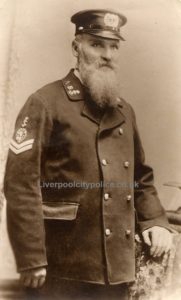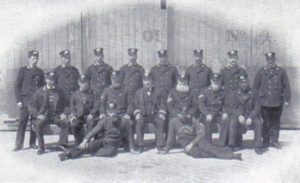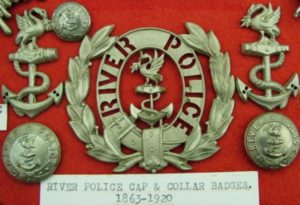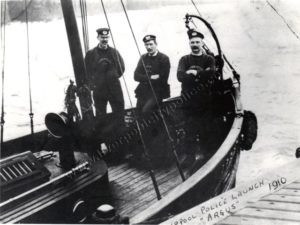LIVERPOOL RIVER POLICE by brian starkey and peter dellius, retired
The River Mersey has borne silent witness to much over the years,non more so that during the American Civil War, the North of England supported the Confederacy due to its reliance on the Cotton producing South. So in addittion to the normal lawlessness one would associate with a Seaport the size of Liverpool, there was the intrigue associated with the support of the Confederate States of America (The CSA Embassy was in Rumford Place, Liverpool 2) including the Smuggling of General goods and the illegal transportation of Gunpowder.
In 1825 the Watch Committee employed “Fire Police” on the dock estate. Fire was, of course, the great hazard in those days and the prevention of ship and dock fires was at least as important as the prevention and detection of cargo thefts.
The advent of the Liverpool Borough Police in 1836 saw the absorbing of the Watch and Fire Police and in 1858 stations manned by Police Firemen were opened at Princes, Brunswick, Collingwood and Salt House Docks. Salthouse Dock was for many years the ‘Guinness Berth’ and the story has it that the town beat Constable was to be seen struggling with two full buckets of ‘Liffey Water’ (Guinness) to refesh his night duty colleagues at nearby Argyll Street Bridewell.
At a meeting of the Liverpool Borough Police Watch Committee on the 12th January 1865, upon the recommendation of the Head Constable, the Mersey Docks and Harbour Company agreed to fund a River (Mersey) Police. The MD&HB would completely fund the River Police but the Officers would be sworn in as Liverpool Borough Constables and would come under the direction of the Head Constable.
The River Police was formed in June 1865, with the responsibility of patrolling the river itself. Its initial strength consisted of one Inspector, three Sergeants and thirteen Constables.
The main duties of the New Force related to the movement of Cargo and Policing of general movement of Seamen, cargo and Explosives. Volatile Explosives and ammunition would be removed by the River Police and would be taken to the Magazines at New Brighton.
Although a part of the Borough Police, the officers of the River Police wore a seperate distinctive Badge and collar dogs. These would be worn on a Naval style double breasted reefer coat. The main working uniform of men was normal uniform issue trousers and a thick Naval Pullover with the Police logo and in some instances the officers number thereon.
The role of the River Police was a dangerous one as the duties entailed weaving in and out of the shipping lanes, Boarding moving boats and the rescue of persons in distress. On the 3rd February 1868 tragedy struck when the River Police Launch capsized mid river and Constable Henry Madden, Aged 40 was lost overboard and drowned.
On the 6th of June 1871, The River Police appeared on the reported strength of the Borough of Liverpool Police and consisted of : –
3 Coxwains (Sergeants)
14 Constables
On the evening of the 15th of February 1920 the River Police ceased to exist as such and the officers were absorbed into Liverpool City Police.
In 1972, the old Mersey Docks & Harbour Board was “privatised” and became the Mersey Docks and Harbour Company. Some time after privatisation the Company conducted a review of policing and discovered that they were being charged for the deployment of each Police officer at “private rate”. In other words the officer’s salary PLUS two thirds. The “contract” was quite specific and indeed only “top rate” officers could be posted to the docks (no probationers or newly promoted), that was because the MD&HC were paying the top salary for each rank. In actual fact the Police Authority were making a healthy profit out of the arrangement as indeed had been the case since the mid 1800’s when the old Dock Police were amalgamated with the Borough Police. The high cost was not commercially sustainable. The MD&HC concluded that if they employed officers directly it would in theory cut its policing budget by at least two thirds. Those officers who were posted to the docks were actually “additional” to the authorised establishment of the force and that had always been the case. When the Port Police became operational the “redundant” dock men were posted to divisions and actually filled vacancies in the authorised establishment. The handover of policing was incremental and on the Liverpool side of the river was completed on 4th January 1977. The whole transition was completed in April of that year when the docks at Birkenhead (“F” Div.) were handed over.
The Port of Liverpool Police survives to the present day.





